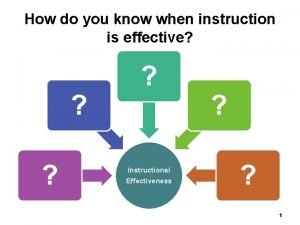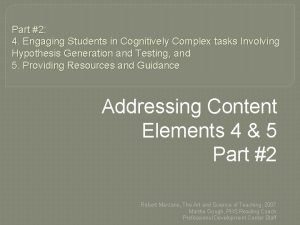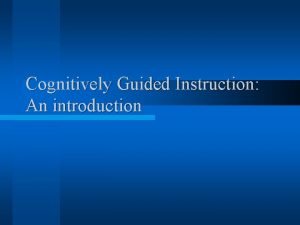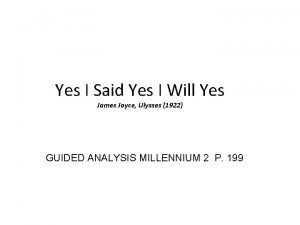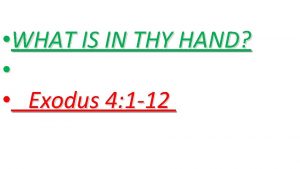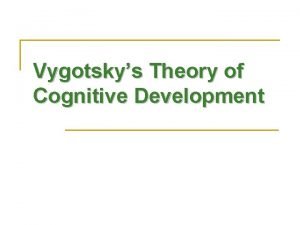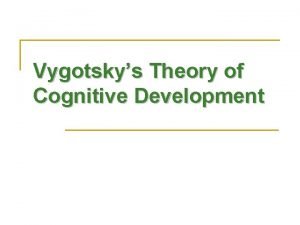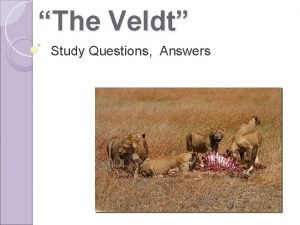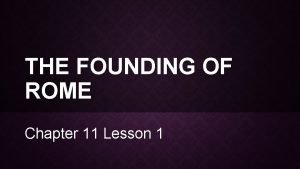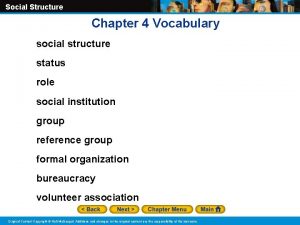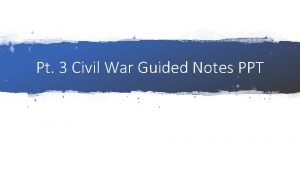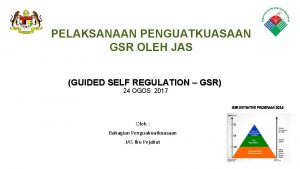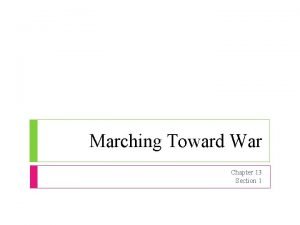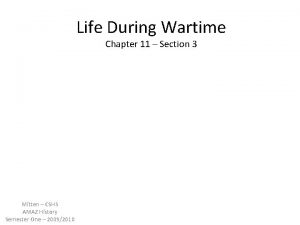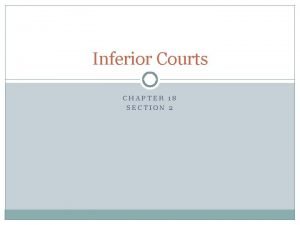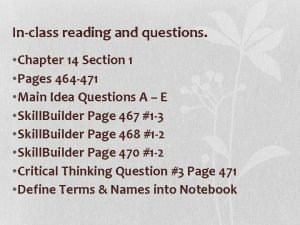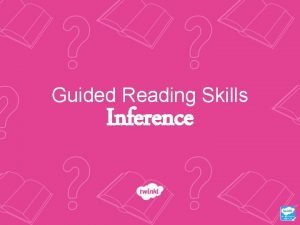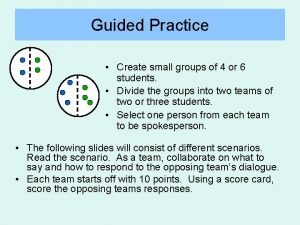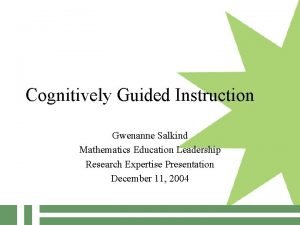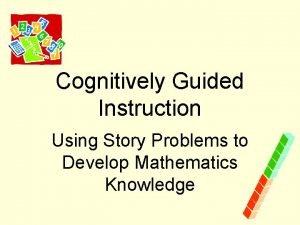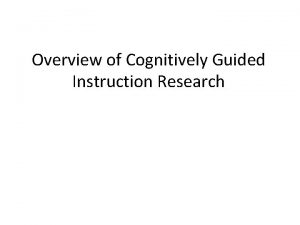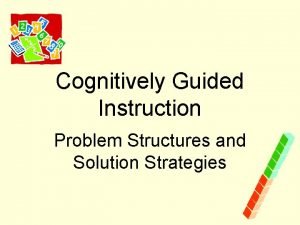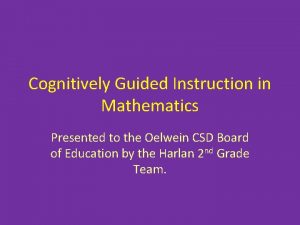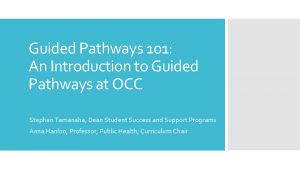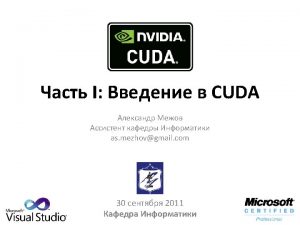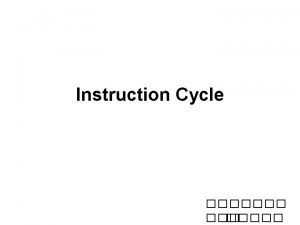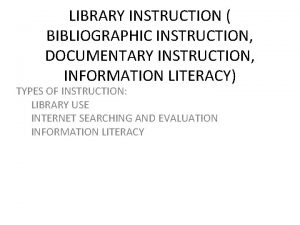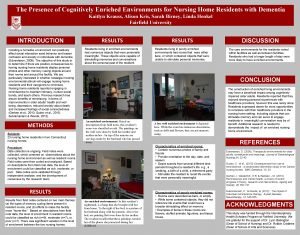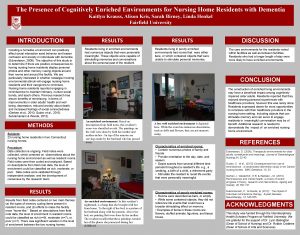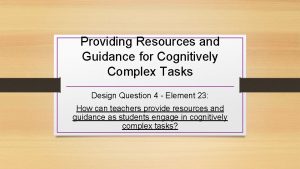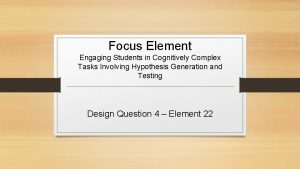Cognitively Guided Instruction An introduction Cognitively Guided Instruction





































- Slides: 37

Cognitively Guided Instruction: An introduction

Cognitively Guided Instruction (CGI) l A method of instruction, used especially for teaching arithmetic, based on: – knowledge of students’ current abilities; – usual cognitive development; – levels of difficulties of the tasks assigned Based on research by Thomas Carpenter and colleagues from University of Wisconsin Madison l Assumes that children learn best when they figure things out for themselves, rather than being shown algorithms (“constructivism”) l

CGI basics, continued Students are presented with problems in context (I. e. , story problems) l Story problems vary in difficulty based on how they are worded l Level of difficulty is determined through research into how young children approach the problem when they can count, but have not memorized any “math facts” or other strategies for doing addition, subtraction or other operations l

Addition and Subtraction

Join Problems (3 types) l Result unknown (JRU) l Example: Connie had 5 marbles. Juan gave her 8 more marbles. How many marbles does Connie have now? l Symbolized by 8+5= ?

Join Problems l Change unknown (JCU) l Example: Connie had 5 marbles. Juan gave her some more marbles. Now Connie has 13 marbles. How many marbles did Juan give her? l Symbolized by 8+? = 13

Join Problems l Start unknown (JSU) l Example: Connie had some marbles. Juan gave her 8 more marbles. Now Connie has 13 marbles. How many marbles did she start with? l Symbolized by ? +8= 13

Separate Problems (3 types) l Result unknown (SRU) l Example: Connie had 13 marbles. She gave 5 to Juan. How many marbles does Connie have left? l Symbolized by 13 -5= ?

Separate Problems l Change unknown (SCU) l Example: Connie had 13 marbles. She gave some to Juan. Now she has 5 left. How many marbles did she give to Juan? l Symbolized by 13 -? = 5

Separate Problems l Start unknown (SSU) l Example: Connie had some marbles. She gave 8 to Juan. Now she has 5 left. How many marbles did she start with? l Symbolized by ? - 8 = 5

Part-Whole Problems (2 types) l Whole unknown (PPW-WU) l Example: Connie has 5 red marbles and 8 blue marbles. How many marbles does she have? l Symbolized by 5+ 8 = ?

Part-Whole Problems (also called Equalizing Problems) l Part unknown (PPW-PU) l Example: Connie has 13 marbles. 5 are red, and the rest are blue. How many blue marbles does she have? l Symbolized by 5+ ? = 13

Compare Problems (3 types) l Difference unknown (CDU) l Example: Connie has 13 marbles. Juan has 5 marbles. How many more marbles does Connie have than Juan?

Compare Problems l Compare quantity unknown (C-CQU) l Example: Juan has 5 marbles. Connie has 8 more than Juan. How many marbles does Connie have? l Symbolized (but not precisely) by 5+8=?

Compare Problems l Compare referent unknown l Example: Connie has 13 marbles. She has 5 more marbles than Juan. How many marbles does Juan have?

Solution Strategies l There are three levels that students typically go through in solving problems: – Direct modeling – Counting – Derived facts

Direct Modeling: all numbers represented, number order and “verb” are important! Child draws or chooses counters to represent the first number in the problem. (e. g. Jen had 3 candies. Then she got 5 more. How many does Jen have now? ) l Then child draws or chooses counters to represent the second number l The child physically moves the two groups together (or circles them, etc. ) and counts all, starting with 1 l

Direct Modeling l Start unknown problems are difficult to model. Some students attempt to solve them using trial and error

Counting Strategies l JRU: Counting on from first (3+5=? : the child begins counting from 3) l JRU: Counting on from larger (3+5=? : the child begins counting from 5) l JCU: Counting on to (3+? =8: the child counts from 3 until 8 is reached; the answer is the number of counting words in the sequence)

Counting Strategies l SRU: Counting down (8 -3=? : the child counts backward from 8 for 3 counts) l SCU: Counting down to (8 -? =3: the child counts down from 8 until 3 is reached; the answer is the number of counting words in the sequence)

Derived facts l You will see this on the worksheet assigned for homework and in the videos we will watch next week.

Multiplication and Division

Grouping and Partitioning Problems Multiplication: Megan has 5 bags of cookies. There are 3 cookies in each bag. How many cookies does Megan have all together? l Measurement division: Megan has 15 cookies. She puts 3 cookies in each bag. How many bags can she fill? l Partitive division: Megan has 15 cookies. She put the cookies into 5 bags with the same number of cookies in each bag. How many cookies are in each bag? l

Solution Strategies l Direct modeling l Counting l Derived facts

Direct Modeling Multiplication: The child draws out the 5 bags of 3 cookies and counts them all l Measurement division: The child starts with 15 objects and takes away groups of 3 until they are all gone. The number of groups is the answer. l Partitive division: The child starts with 15 objects and gives one at a time to each of the 5 groups until they are gone. The number of objects in each group is the answer. l

Counting strategies l Multiplication: skip counting, addition l Measurement division: skip counting, addition or subtraction l Partitive division: trial and error

Derived facts l You will see examples when we watch multiplication and division videos.

Assignment for next meeting l Briefly describe a children’s story book including author and appropriate age/grade. l Prepare a list of 6 different types of story problems based on that book. l On the back of your paper, identify what kind of problem each one is.

Story Problems from Literature: An example from a former student

EDUC 406 - Math Word Problems By Tefang Li

Contents Introduction of the story book Word Problems The End Click the house to read the contents

Old Mac. Donald Had a Farm Illustrated by Tracey English l Western Publishing Company l It’s a counting book. Each time when the song is repeated with a different animal, one more counting number is added. l At the end, it includes a full page of all the different animals and the counting numbers from 1 to 10. l Click here to go next

Word Problem Join Separate Part-Whole Compare

Join Type of Problems 1. Old Mac. Donald had 6 hens in the barn and then he bought 5 more hens. How many hens does he have altogether? (Result Unknown, JRU) 2. Old Mc. Donald had some pigs and his friend gave him 2 more pigs. Now he has 15 pigs. How many pigs did he have before he got the 2 new pigs from his friend? (Start Unknown, JSU)

Separate Type of Problems 1. Old Mc. Donald had 19 sheep. One day, he sold some of his sheep and then he had 11 sheep left. How many sheep did he sell? (Change Unknown, SCU) 2. There were some apples in a basket. The horse ate 3 of them and then there were 9 apples left. How many apples were in the basket in the first place? (Start unknown, SSU)

Part-Whole Type 1. Old Mc. Donald owned 21 horses. 4 of them were sleeping and the rest of them were eating. How many horses were eating? (Part unknown, PPW, PU) 2. Old Mc. Donald had some sheep. 7 were black sheep and 8 were white sheep. How many sheep did he have altogether? (Whole unknown, PPW, WU)

Compare Type 1. The horse on his farm ate 14 apples and the cow on his farm ate 6 apples. How many more apples did the horse eat? (Difference Unknown, CDU) 2. The sheep ate 9 apples, and the goat ate 5 more than the sheep. How many apples did the goat eat? (Compare quantity unknown, CCQU)
 Separate result unknown
Separate result unknown Disadvantages of cognitively guided instruction
Disadvantages of cognitively guided instruction Disadvantages of cognitively guided instruction
Disadvantages of cognitively guided instruction Cognitively demanding
Cognitively demanding Cognitively complex
Cognitively complex Types of attitudes
Types of attitudes Cognitively speaking
Cognitively speaking Cognitively based attitude
Cognitively based attitude Cognitive guided instruction
Cognitive guided instruction Individualized instruction vs differentiated instruction
Individualized instruction vs differentiated instruction Indirect instruction definition
Indirect instruction definition Intro paragraph outline
Intro paragraph outline I said yes i will
I said yes i will Thy hand o god has guided
Thy hand o god has guided Guided participation vygotsky
Guided participation vygotsky Guided participation examples
Guided participation examples The veldt worksheet answer key
The veldt worksheet answer key Guided reading lesson 1 the founding of rome answer key
Guided reading lesson 1 the founding of rome answer key The adolescent in society guided reading
The adolescent in society guided reading Guided reading level chart
Guided reading level chart Guided notes international organizations
Guided notes international organizations Social structure guided reading section 4
Social structure guided reading section 4 Oracle guided learning documentation
Oracle guided learning documentation Ppt
Ppt Percutaneous image-guided lumbar decompression (pild)
Percutaneous image-guided lumbar decompression (pild) Guided self regulation
Guided self regulation Perfect squares 1-10000
Perfect squares 1-10000 Chapter 13 section 1 marching toward war
Chapter 13 section 1 marching toward war Chapter 11 section 3 life during wartime
Chapter 11 section 3 life during wartime Chapter 9 section 1 labor market trends
Chapter 9 section 1 labor market trends Ischemia-guided strategy
Ischemia-guided strategy Chapter 18 section 2 the inferior courts answer key
Chapter 18 section 2 the inferior courts answer key Chapter 10 lesson 1 the industrial revolution
Chapter 10 lesson 1 the industrial revolution Guided reading chapter 14 section 1
Guided reading chapter 14 section 1 What is shared reading
What is shared reading Guided reading inference
Guided reading inference What is guided practice
What is guided practice Guided local search
Guided local search


